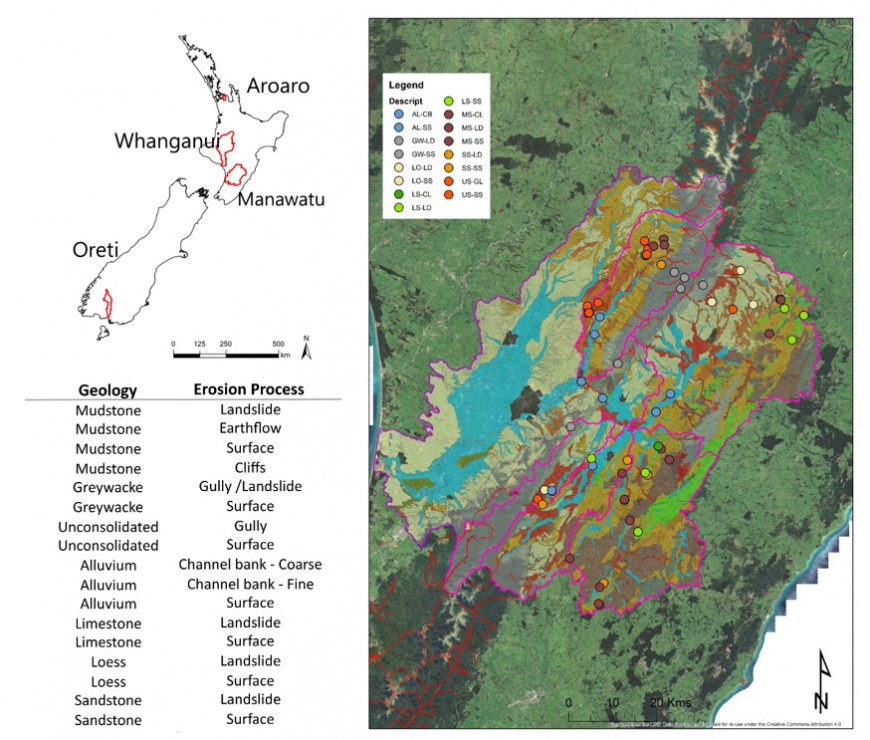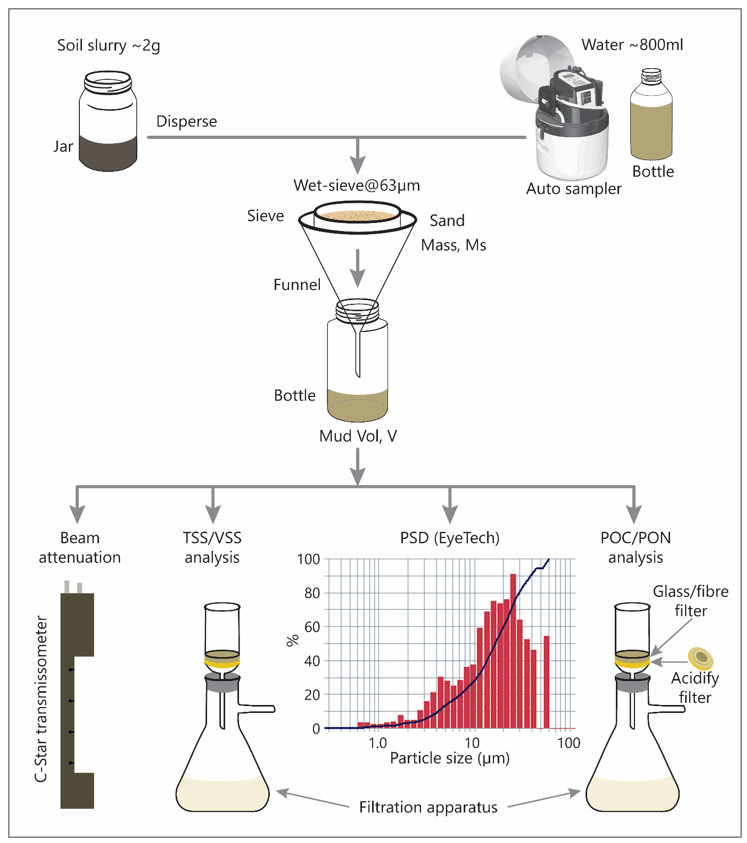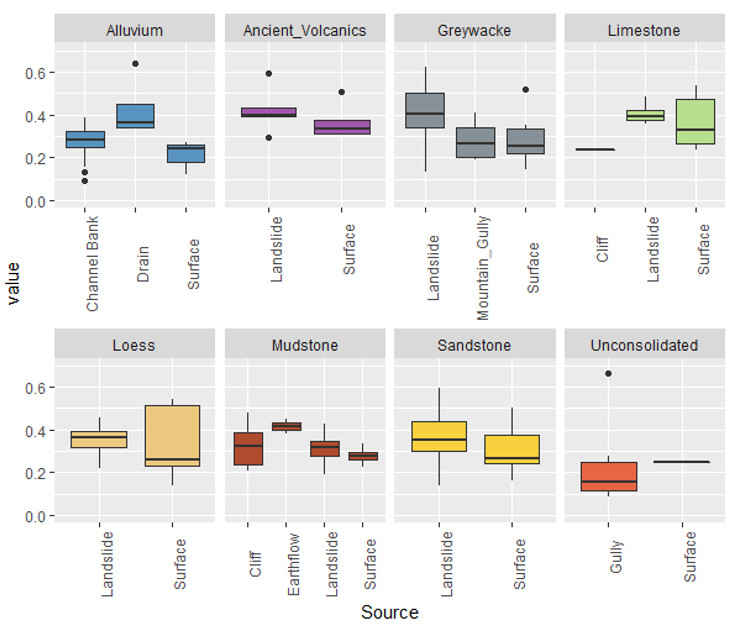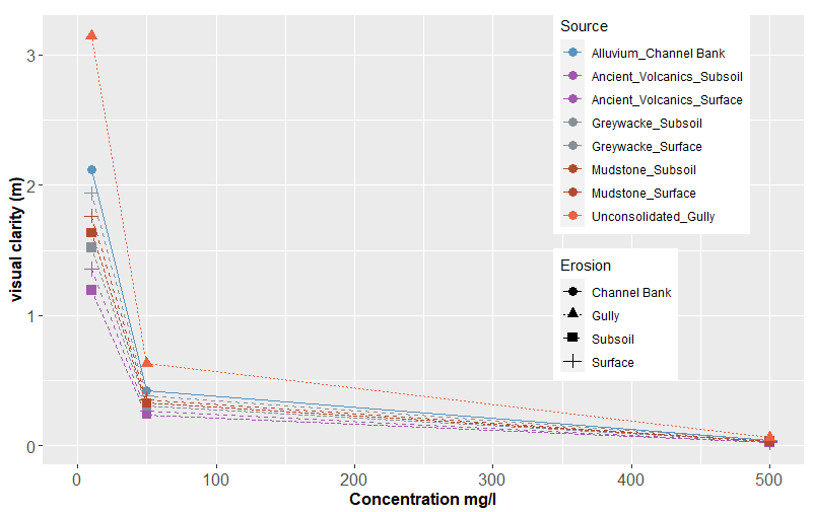- Home
- ...
- Smarter Targeting of Erosion Control (STEC)
- Smarter Targeting of Erosion Control (STEC) News
Erosion source attributes and their impact on sediment-related water quality
This presents a significant knowledge gap since sediment properties that affect water quality, notably optical characteristics, may vary across catchment, geology, and erosion process. This issue is particularly relevant to New Zealand, given recent regulatory changes relating to the National Policy Statement for Freshwater Management (NPS-FM) and National Objectives Framework (NOF) – including standards for sediment expressed in terms of visual clarity (see Table 8 in NPS-FM 2020). It is important that sediment properties and how they vary across a landscape are considered when designing erosion mitigation strategies to address the impact of sediment on water quality.

Figure 1 Top left: Map of new Zealand showing main focus catchments. Right: Manawatū catchment showing underlying geology and spatial pattern of sampling. Bottom left: Example of sample classification based on geology and erosion process used in Manawatū catchment.
A central component of the STEC programme seeks to address this challenge by better linking erosion sources to water quality both of fresh and coastal waters. This involves collecting new data to characterise soil and sediment properties corresponding to different erosion processes and underlying parent materials (rock type) as well as suspended sediment to inform spatial and temporal modelling (i.e. ‘Temporal Erosion and Sediment Transport’ (TEST) model, described in an earlier newsletter). Erosion source and suspended sediment sampling focuses on four New Zealand catchments (Fig. 1). Sediment attributes measured include: particle size distributions and statistics (e.g. median diameter and the size distribution curve), Particulate Organic Carbon (POC), Particulate Organic Nitrogen (PON), Suspended Solids (SS), Inorganic Suspended Solids (Inorg SS), Volatile Suspended Solids (VSS), and light attenuation (Beam c). In-stream suspended sediment samples are being collected across a range of flow conditions. These are being analysed for the same sediment properties using a harmonised procedure (Fig. 2) that directly links sources and suspended sediment as regards water quality.

Figure 2 Schematic of harmonised analytical procedure for source and suspended sediments showing attributes measured.
At present, sampling has been completed for the Manawatū and Ōreti catchments. Initial analysis of these data has already revealed some interesting patterns in Beam c and visual clarity. Fine sediment varies greatly in particle size and surface properties, which, in turn, influence how light interacts with the sediment and the resulting visual clarity. Light beam attenutation (Beam c) divided by mass concentration gives light beam attenuation per unit mass (Beam c*), which characterises the impact on light attenuation. Differences in the mean and range of this value across erosion processes and underlying geology are clearly observed (Fig. 3). For example, gully sediment in unconsolidated sandstone displays a lower Beam c* value than landslide and surface sediment sources for many other rock types. This likely mostly reflects the varying dominant particle size of the sediment as well as other inherent characteristics of the sediment and how it interacts with light (e.g. organic matter and shape).

Figure 3 Boxplot showing Beam c* for geology and erosion process. Beam c* = Beam attenuation coefficient per unit of mass (c* = c/TSS, units m2/g).
It is important to understand how ‘Beam c’ translates to visual clarity in waters. Since ‘Beam c’ is inversely related to visual clarity, we can estimate visual clarity for known sediment concentrations and simulate how this varies depending on erosion source under ideal conditions (i.e. no change to sediment properties during transport). Using sediment concentrations of 10, 50, and 500 mg/l to reflect a range of flow conditions, we can see that at higher sediment concentrations of 500 mg/l, which reflect a storm event, visual clarity is very low for all sediment sources (Fig. 4). However, as sediment concentration decreases, the diversity in visual clarity produced by the different sediment sources increases. At a concentration of 10 mg/l (typical of low states of flow), differences in visual clarity can be marked. At this concentration, sediment from gullies in unconsolidated sandstone produce a visual clarity of ~3 m – almost twice the visual clarity downstream of other erosion sources. This means that reducing the quantity of sediment originating from this source will have less impact on optical quality than reducing sediment from other erosion sources.

Figure 4 Visual clarity based on source plotted against concentration. As concentration decreases, the difference in visual clarity between sources increases.
The sediment quality attributes and the relationship between parent material and erosion process will be used to develop simplified models for predicting sediment attributes of erosion sources across New Zealand. This will then be used to inform development of spatial-temporal sediment models to link erosion process to sediment-related water quality effects.

